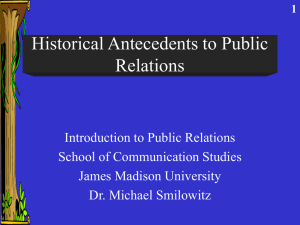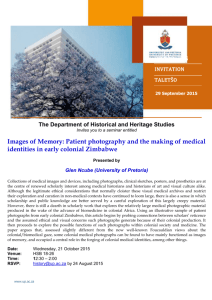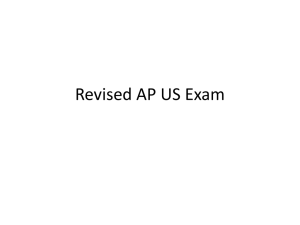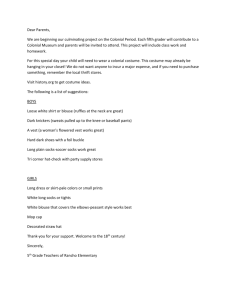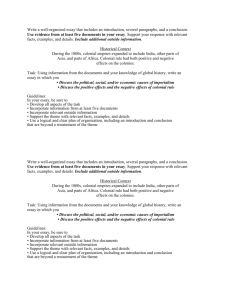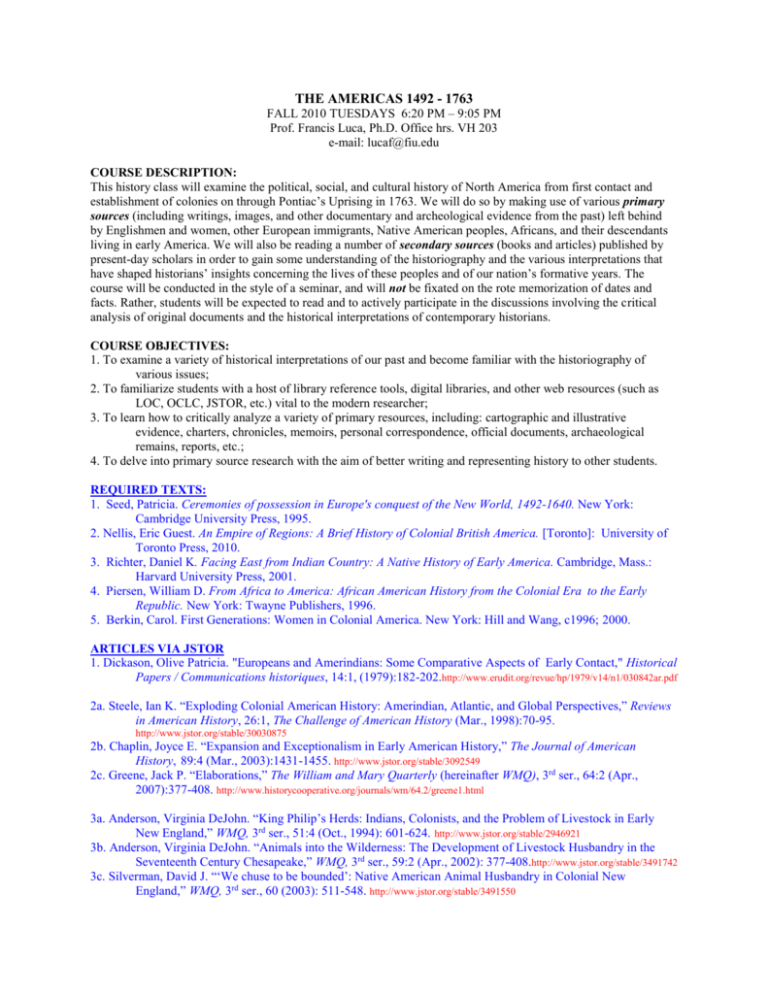
THE AMERICAS 1492 - 1763
FALL 2010 TUESDAYS 6:20 PM – 9:05 PM
Prof. Francis Luca, Ph.D. Office hrs. VH 203
e-mail: lucaf@fiu.edu
COURSE DESCRIPTION:
This history class will examine the political, social, and cultural history of North America from first contact and
establishment of colonies on through Pontiac’s Uprising in 1763. We will do so by making use of various primary
sources (including writings, images, and other documentary and archeological evidence from the past) left behind
by Englishmen and women, other European immigrants, Native American peoples, Africans, and their descendants
living in early America. We will also be reading a number of secondary sources (books and articles) published by
present-day scholars in order to gain some understanding of the historiography and the various interpretations that
have shaped historians’ insights concerning the lives of these peoples and of our nation’s formative years. The
course will be conducted in the style of a seminar, and will not be fixated on the rote memorization of dates and
facts. Rather, students will be expected to read and to actively participate in the discussions involving the critical
analysis of original documents and the historical interpretations of contemporary historians.
COURSE OBJECTIVES:
1. To examine a variety of historical interpretations of our past and become familiar with the historiography of
various issues;
2. To familiarize students with a host of library reference tools, digital libraries, and other web resources (such as
LOC, OCLC, JSTOR, etc.) vital to the modern researcher;
3. To learn how to critically analyze a variety of primary resources, including: cartographic and illustrative
evidence, charters, chronicles, memoirs, personal correspondence, official documents, archaeological
remains, reports, etc.;
4. To delve into primary source research with the aim of better writing and representing history to other students.
REQUIRED TEXTS:
1. Seed, Patricia. Ceremonies of possession in Europe's conquest of the New World, 1492-1640. New York:
Cambridge University Press, 1995.
2. Nellis, Eric Guest. An Empire of Regions: A Brief History of Colonial British America. [Toronto]: University of
Toronto Press, 2010.
3. Richter, Daniel K. Facing East from Indian Country: A Native History of Early America. Cambridge, Mass.:
Harvard University Press, 2001.
4. Piersen, William D. From Africa to America: African American History from the Colonial Era to the Early
Republic. New York: Twayne Publishers, 1996.
5. Berkin, Carol. First Generations: Women in Colonial America. New York: Hill and Wang, c1996; 2000.
ARTICLES VIA JSTOR
1. Dickason, Olive Patricia. "Europeans and Amerindians: Some Comparative Aspects of Early Contact," Historical
Papers / Communications historiques, 14:1, (1979):182-202.http://www.erudit.org/revue/hp/1979/v14/n1/030842ar.pdf
2a. Steele, Ian K. “Exploding Colonial American History: Amerindian, Atlantic, and Global Perspectives,” Reviews
in American History, 26:1, The Challenge of American History (Mar., 1998):70-95.
http://www.jstor.org/stable/30030875
2b. Chaplin, Joyce E. “Expansion and Exceptionalism in Early American History,” The Journal of American
History, 89:4 (Mar., 2003):1431-1455. http://www.jstor.org/stable/3092549
2c. Greene, Jack P. “Elaborations,” The William and Mary Quarterly (hereinafter WMQ), 3rd ser., 64:2 (Apr.,
2007):377-408. http://www.historycooperative.org/journals/wm/64.2/greene1.html
3a. Anderson, Virginia DeJohn. “King Philip’s Herds: Indians, Colonists, and the Problem of Livestock in Early
New England,” WMQ, 3rd ser., 51:4 (Oct., 1994): 601-624. http://www.jstor.org/stable/2946921
3b. Anderson, Virginia DeJohn. “Animals into the Wilderness: The Development of Livestock Husbandry in the
Seventeenth Century Chesapeake,” WMQ, 3rd ser., 59:2 (Apr., 2002): 377-408.http://www.jstor.org/stable/3491742
3c. Silverman, David J. “‘We chuse to be bounded’: Native American Animal Husbandry in Colonial New
England,” WMQ, 3rd ser., 60 (2003): 511-548. http://www.jstor.org/stable/3491550
4a. Berlin, Ira. “Time, Space, and the Evolution of Afro-American Society on British Mainland North America,”
The American Historical Review, 85:1 (Feb., 1980):44-78. http://www.jstor.org/stable/1853424
4b. Caney, Judith A., “From Hands to Tutors: African Expertise in the South Carolina Rice Economy,” Agricultural
History 67:3 (Summer, 1993):1-30.
4c. Samford, Patricia. “The Archaeology of African-American Slavery and Material Culture,” WMQ, 3rd ser., 53:1,
Material Culture in Early America (Jan., 1996):87-114. http://www.jstor.org/stable/2946825
5a. Brown, Kathleen M. “Beyond the Great Debates: Gender and Race in Early America,” Reviews in American
History, 26:1, The Challenge of American History (Mar., 1998):96-123. http://www.jstor.org/stable/30030876
5b. Carney, Judith, “Rice Milling, Gender and Slave Labour in Colonial South Carolina,” Past & Present, 153
(Nov., 1996):108-134. http://www.jstor.org/stable/651137
5c. Potter, Tiffany. “Writing Indigenous Femininity: Mary Rowlandson's Narrative of Captivity,” EighteenthCentury Studies, 36:2, False Arcadias (Winter, 2003):153-167. http://www.jstor.org/stable/30053358
CLASS ATTENDANCE AND PARTICIPATION
Class attendance is mandatory. You are expected not only to attend classes, but also to contribute significantly to
class discussions, expressing your ideas, asking questions, and otherwise advancing the weekly topics under
consideration. You are expected to do all of the required secondary source readings each week and to come to class
prepared to discuss them in relation to primary source materials made available to you via: www.lucahistory.org.
You are expected to participate actively in your own education. What you say in class should reveal a sound
understanding of the readings and other course material. No one will be penalized for coming up with “wrong”
answers; however, not all answers or observations are weighted equally. Feel free to question any aspect of course
content, but should also be prepared to defend your positions and demonstrate a firm command of the primary and
secondary source readings. The quality of one's commentary and questions will carry more weight than the
quantity of times a person chooses to speak up.
GRADES
Class participation………………………………………………………………………………………………..10%
(5) three-to-four page essays integrating secondary and primary sources* (10% each):……..……………..50%
Powerpoint** presented in class (a 12-15 minute version)…....………………..…………………..……….....10%
Powerpoint** Presentation (50 minute version, complete with lesson plan)…….……..………………..……30%
* Essay topics: While I have posed a number of possible questions for consideration, I encourage you to fashion
your own argument on the various essay topics. I do, however, expect all of the essays to reference the required
readings (books and/or articles) and primary source documents provided on line at www.lucahistory.org. Any good
essay, of course, must have a strong thesis statement (or argument).
** Powerpoint presentations will be on a single topic of your choosing, integrating cartographic and illustrative
primary source evidence. You will deliver the abbreviated version to your peers on one of two last class meetings;
The long-play version to be turned in on last day of class on an expendable—ie., will not be returned) flash drive
memory stick to be reviewed and graded by your professor. While there are no minimum or maximum number of
slides, experience has favored the use of 5 to 10 frames for the short in-class presentation, and 25 to 50 frames for
the longer version.
PLAGIARISM is a serious breach of the university honor code, and as such, will not be tolerated in the least.
Anyone who uses the work of other authors without properly citing sources of ideas and information WILL
RECEIVE AN AUTOMATIC FAILING GRADE FOR THE CLASS AND WILL BE SUBJECT TO
UNIVERSITY DISCIPLINARY ACTION.
TUESDAY, AUG. 24:
INTRODUCTION TO COURSE AND WEB SOURCES
Review of syllabus, class expectations, grading policy, review essays, class participation, final Powerpoint project.
Learning about and accessing resources beyond the library shelves:
Online Union Catalogs: (OCLC or Worldcat); Virtual Libraries: (American Memory from L.O.C.); Online
book reviews, articles, etc.: (JSTOR); Documents available on-line: (Publications of Archival, Library and
Museum Materials (PALMM); Early Americas Digital Archive (EADA); American Journeys; Avalon
Project; Internet Medieval Sourcebook; Virtual Jamestown; Plymouth Colony Archive Project; Google
books; Google scholar; Digital sources for images: John Carter Brown Library; Google images; others?
POWER POINT PRESENTATION NO. ONE: Images downloaded from the World Wide Web relating to the
European exploration and colonization of the Americas. This exercise is intended to introduce the students to the
idea of image analysis or “visual literacy,” how images can be used as historical documents, and to show them how
much of these materials can be found online. Images range from 17 th century engravings and maps, recovered
archaeological artifacts, artists’ sketches, portrait and landscape paintings, editorial cartoons, and even some
historical reconstructions and recreations of places and events.
TUESDAY, AUG. 31:
ENGLISH AND OTHER COLONIAL COMPETITORS IN THE AMERICAS
READ: Seed, Patricia. Ceremonies of Possession in Europe's Conquest of the New World, 1492-1640.
CHOOSE A PRIMARY SOURCE DOCUMENT FOR ONE OF THE EUROPEAN COLONIZERS
FEATURED IN PATRICIA SEED’S CEREMONIES OF POSSESSION FROM EITHER:
A. American Journeys: A Digital Library of Early American Exploration and Settlement
http://www.americanjourneys.org/texts.asp ; or
B. Internet Medieval Sourcebook http://www.fordham.edu/halsall/sbook1z.html ; or
C. Early Americas Digital Archive http://www.mith2.umd.edu/eada/search.php
D. The Avalon Project http://avalon.law.yale.edu/subject_menus/statech.asp
PREPARE A THREE MINUTE ORAL REPORT FOR PRESENTATION IN CLASS:
Using your primary source evidence, test the thesis, and assumptions of the corresponding chapter in Patricia Seed’s
Ceremonies of Possession and/or the argument made by Olive P. Dickason in her article: “Europeans and Indians.”
TURN YOUR ORAL REPORT INTO A 3 TO 5 PAGE ESSAY DUE SEPTEMBER 7: How does Seed’s
chapter argument regarding one of the colonial powers stand up to the primary sources?
TUESDAY, SEPT. 7:
HISTORIOGRAPHY OF AN “ATLANTIC WORLD” PERSPECTIVE
POWER POINT PRESENTATION NO. TWO: Images downloaded from the Web relating to the Spanish colony to
the South in La Florida; the French colony to the North in Canada; the English colonies of settlers in the Chesapeake
and New England regions; and the Swedes and Dutch in the middle.
READ: Steele, “Exploding Colonial American History,” Reviews in American History, 26:1 (Mar., 1998):70-95 ;
Chaplin, “Expansion and Exceptionalism in Early American History,” JAH, 89:4 (Mar., 2003):1431-1455 ; Greene,
Jack P. “Elaborations,” WMQ, 3rd ser., 64:2 (Apr., 2007):377-408 ; Chapters 1-4 in Nellis, An Empire of Regions (p.
ix-158)
TUESDAY, SEPT. 14:
COLONIAL EXPANSION, MATURATION & IMPERIAL REORGANIZATION
POWER POINT PRESENTATION NO. THREE: Images downloaded from the Web relating to the English
settlement of the lower Southern colonies (South Carolina and Georgia), the “Middle Colonies” (Delaware, the
Jerseys, Pennsylvania, New York) and the Backcountry (Western “frontier” settlements on the eastern valley of the
Appalachians).
READ: Chapters 5-10 in Nellis, An Empire of Regions (p. 158-308) ; primary source documents for the BRITISH
COLONIES (THE SOUTH, NEW ENGLAND, THE MIDDLE COLONIES, THE BACKCOUNTRY) made
available on my website: www.lucahistory.org
SECOND 3 TO 5 PAGE ESSAY DUE SEPTEMBER 21: According to Nellis, how did English imperial
policies, the goals and visions of colonial founders and charter generations, and distinctive regional
environments create an empire of regions in early America? Where does it stand in the historiography of
colonial America and how well does it address the issues and questions historians have asked of the era? Does
Nellis’s thesis persuasively explain the diversity of colonial cultures in the Americas prior to the crisis of the
1760s and ‘70s culminating in the American Revolution? How does it fare when compared to the primary
source readings? Is there anything missing from or lacking in his historical interpretation?
TUESDAY, SEPT. 21: RECONSIDERING OUR ORIENTATION: THE VIEW FROM INDIAN COUNTRY
POWER POINT PRESENTATION NO. THREE: Images downloaded from the World Wide Web relating to the
INDIAN influence in Early America.
READ: Prologue, Chapters 1-3 in Richter, Facing East from Indian Country, (p. 1-109) ; Anderson, “King Philip’s
Herds,” WMQ, 3rd ser., 51:4 (Oct., 1994): 601-624 ; Anderson, “Animals into the Wilderness,” WMQ, 3rd ser., 59:2
(Apr., 2002): 377-408 ; Silverman, “‘We chuse to be bounded,’” WMQ, 3rd ser., 60 (2003): 511-548.
TUESDAY, SEPT. 28:
NATIVE AMERICANS IN A NEW COLONIAL WORLD
READ: Chapters 4-6 in Richter, Facing East from Indian Country, (p. 110-216) ; primary source documents for the
INDIAN AMERICA from www.lucahistory.org
THIRD 3 TO 5 PAGE ESSAY DUE OCTOBER 5: Is Richter’s thesis regarding the primacy of Indians in the
colonial era supported by the primary sources? What were the historical events and processes that
transformed the “Indian country” into a “new” world dominated by European colonists, and turned
independent and autonomous Indian cultures into fragmented dependencies? Alternatively, what do the new
Environmental History studies contribute to our understanding of the dynamics of European-Indian contact
and interaction in the colonial era?
TUESDAY, OCT. 5:
AFRICANS IN COLONIAL AMERICA
POWER POINT PRESENTATION NO. FOUR: Images downloaded from the World Wide Web relating to
AFRICAN-AMERICAN contributions to colonial America.
READ: Berlin, “Time, Space, and the Evolution of Afro-American Society on British Mainland North America,”
The American Historical Review, 85:1 (Feb., 1980):44-78 ; Caney, “From Hands to Tutors,” Agricultural History
67:3 (Summer, 1993):1-30 ; Samford, “The Archaeology of African-American Slavery and Material Culture,”
WMQ, 3rd ser., 53:1 (Jan., 1996):87-114.
TUESDAY, OCT. 12:
AFRICAN CONTRIBUTIONS TO COLONIAL AMERICA
READ: Piersen, From Africa to America, p. xi-130 ; primary source documents for the AFRICAN AMERICA
from www.lucahistory.org
FOURTH 3 TO 5 PAGE ESSAY DUE OCTOBER 5: What is Piersen’s central thesis and how well supported
is it by the primary sources? What types of evidence does he and other scholars (Caney, Samford) make use
of? How convincing are their arguments? Does a focus on African contributions to colonial American society
and culture distract from African Americans experience with the hardships of slavery? Was slavery a
monolithic system? Were geographical and temporal significant factors in shaping the “peculiar institution”?
TUESDAY, OCT. 19:
ADDING HER STORY INTO COLONIAL AMERICAN HIS-STORY
POWER POINT PRESENTATION NO. FIVE: Images downloaded from the World Wide Web relating to
WOMEN and issues of gender in the making of American Civilization.
READ: Brown, “Beyond the Great Debates,” Reviews in American History, 26:1 (Mar., 1998):96-123 ; Carney,
“Rice Milling, Gender and Slave Labour in Colonial South Carolina,” Past & Present, 153 (Nov., 1996):108-134 ;
Potter, “Writing Indigenous Femininity: Mary Rowlandson's Narrative of Captivity,” Eighteenth-Century Studies,
36:2 (Winter, 2003):153-167 ; Preface, chapters 1-3, in Berkin, First Generations, vi-78.
TUESDAY, OCT. 26:
FROM WOMEN’S HISTORY TO AN ENGENDERED HISTORY
READ: Chapters 4-6, in Berkin, First Generations, p. 79-164 ; primary source documents for an ENGENDERED
AMERICA from www.lucahistory.org
OUTLINE OF TOPIC FOR FINAL POWERPOINT PROJECTS ALSO DUE THIS DAY
FIFTH 3 TO 5 PAGE ESSAY DUE NOV. 2: How does Berkin’s thesis regarding women in the early
Americas stand up to the primary sources? Does an engendered approach to history do more than merely
reinsert women into the past? Does this approach modify our assumptions and interpretations of our colonial
heritage?
TUESDAY, NOV. 2: CLASS TUTORIAL & WORKSHOP: WE WILL MEET TO DISCUSS PROGRESS
AND PROBLEMS WITH THE POWERPOINT PROJECTS
TUESDAY, NOV. 9: CLASS TUTORIAL & WORKSHOP, CONTINUED
TUESDAY, NOV 16: CLASS PRESENTATIONS OF ABBREVIATED POWERPOINT PROJECTS BEGIN
TUESDAY, NOV. 23: CLASS PRESENTATIONS CONTINUE
TUESDAY, NOV. 30: CLASS PRESENTATIONS RESUME AND CONCLUDE; FULL-LENGTH
POWERPOINT PROJECTS ON FLASHDRIVE/ MEMORY STICKS MUST BE PASSED THIS DATE
SUGGESTIONS FOR FURTHER READING (Those in red are ideal for use in the classroom):
Fischer, David H. Albion’s Seed: Four British Folkways in America. New York: Oxford University Press, 1989.
Taylor, Alan. American Colonies. New York: Viking, 2001.
Nash, Gary B. Red, white, and black: the peoples of early North America. Upper Saddle River, N.J.: Pearson
Prentice Hall, 2006.
Cronon, William. Changes in the Land: Indians, Colonists, and the Ecology of New England. New York: Hill &
Wang, 1983.
Axtell, James. The Invasion Within: the Contest of Cultures in Colonial North America. New York: Oxford
University Press, c1985.
Calloway, Colin G. New Worlds for All: Indians, Europeans, and the Remaking of Early America. Baltimore:
Johns Hopkins University Press, 1997.
Kupperman, Karen O. Indians and English: Facing Off in Early America. Ithaca: Cornell University Press, 2000.
Silver, Timothy. A New Face on the Countryside: Indians, colonists, and slaves in South Atlantic forests, 15001800. Cambridge; New York: Cambridge University Press, 1990.
Berlin, Ira. Many Thousands Gone: The First Two Centuries of Slavery in North America. Cambridge, Mass.:
Harvard University Press, c1998.
Reiss, Oscar. Blacks in Colonial America. Jefferson, N.C.: McFarland & Co., 1997.
Wood, Betty. Slavery in Colonial America, 1619-1776. Lanham, Md.: Rowman & Littlefield Publishers, 2005. *
(Includes documents)
Ilrich, Laurel. Good wives: image and reality in the lives of women in northern New England, 1650-1750. New
York: Oxford University Press, 1983, ©1982.
Brown, Kathleen. Good wives, nasty wenches, and anxious patriarchs: gender, race, and power in colonial
Virginia. Chapel Hill: University of North Carolina Press, 1996.
Eldridge, Larry D. ed. Women & Freedom in Early America. New York: New York University Press, c1997.
Godbeer, Richard. Sexual revolution in early America. Baltimore, Md.: Johns Hopkins University Press, 2002.
Kerber, Linda K. Women’s America: refocusing the past, Vol. I.: Traditional America, 1600-1820. New York:
Oxford University Press, 7th ed., 2011.* (Includes documents)



